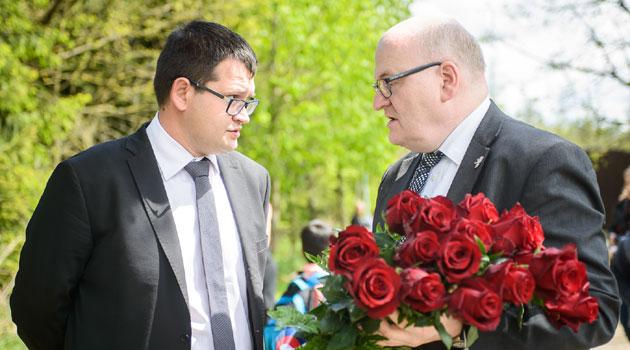Czech ministers say they believe pig farm will be gone from Roma genocide site next year

The surviving relatives of the victims of the concentration camp for Romani people at Lety u Písku, members of the public, Czech Human Rights Minister Jan Chvojka (Czech Social Democratic Party – ČSSD) and Czech Culture Minister Daniel Herman (Christian Democrats – KDU-ČSL) commemorated the Romani victims of Nazism at the Lety Memorial today. An industrial pig farm occupies the places where the concentration camp for Romani people was located during the Second World War.
The Czech Government pledged in its 2020 Roma Strategy to remove the pig farm from the Lety genocide site. The Czech Culture Ministry has commissioned an appraisal of the value of the land, real estate and technical equipment there.
The appraisal is now ready and the value of the farm has been established. “On the basis of the conclusion arrived at by the appraisal we will negotiate with the owner of the pig farm about selling it to the state. Negotiations will be completed within a month and I believe they will be positive and the farm will be bought,” Chvojka told the Czech News Agency.
Chvojka said a specific price has been recommended but would not publicize it prior to the negotiations with the owners. Romani organizations are demanding that the farm be closed.
The Czech Republic has been called upon by the European Parliament and other international institutions more than once to remove the farm from the place of reverence. Today’s ceremony was attended by dozens of people, with organizers estimating the number attending at as many as 200.
Wreaths were laid at the memorial by many embassies, such as those of Germany, Hungary, Israel and Slovakia. There was also a wreath in the name of the President of the Czech Republic.
From the history of the concentration camp at Lety by Písek
In 1940, the area on which the concentration camp would arise at Lety u Písku was being used to house local construction workers. A disciplinary labor camp was then established there at the order of the Interior Minister of the Government of the Protectorate of Bohemia and Moravia, Josef Ježek, on 15 July 1940.
That order was issued on the basis of Government Decree No. 72, on disciplinary labor camps, dated 2 March 1939. That particular decree was issued prior to the Nazi occupation of Czechoslovakia on 15 March 1939.
According to the 2 March 1939 decree, the disciplinary labor camp was to concentrate “wandering gypsies and other vagabonds living that same way, beggars by trade and persons living from the begging of others (children, etc.), gamblers by trade, notorious idlers, loafers, and persons living from dishonest income (prostitution, etc.), whether their own or that of others, who are capable of work.” The first 12 prisoners arrived there on 17 July 1940.
On 1 August 1942 the camp was transformed into a “Gypsy camp” and entire Romani families were transported there. That was the day it began functioning as a concentration camp until its closure on 4 May 1943.
The capacity of the camp at Lety had been increased to 600 prisoners, but that number was soon exceeded, as during August 1942 there were more than 1 100 children, men and women interned there. The camp was not equipped with the necessary hygienic and other facilities for such a large number of persons.
Prisoners frequently had to bathe in a nearby fishpond. Between 1940 and August 1942, only men were imprisoned at Lety.
From August 1942 onward, Romani children and women also rotted away there in absolutely unsatisfactory conditions. After a big onrush of inmates during August 1942, the next arrivals there were mostly either isolated individuals or single families.
A total of 326 persons perished in the camp at Lety, 241 of them children. A total of 120 victims were buried in a temporary mass grave near the camp, while others were buried en masse at the cemetery in nearby Mirovice.
After being transported to Auschwitz, 540 prisoners originally from Lety died there. There were two sets of mass transports from Lety to Auschwitz.
The first such mass transport happemed on 3 December 1942 when 16 men and 78 women labeled “asocials” were sent to the Auschwitz I concentration camp. The second transport of 417 prisoners to the Auschwitz II-Birkenau concentration camp meant the practical liquidation of the Lety camp.
While the first transport from Lety to Auschwitz had been implemented on the basis of a decree about crime prevention, the second transport was realized on the basis of Reichsführer Himmler’s decree from 16 December 1942, which ordered the transport of all Romani people to the Auschwitz concentration camp. The remaining 198 prisoners at Lety were relocated to the “Gypsy camp” at Hodonín u Kunštátu (the so-called Žalov site) or to reception camps in Pardubice and Prague.
On 13 May 1995, at the site of the mass grave near the former camp, a memorial was unveiled reading “To the victims of the gypsy camp at Lety 1942-1943. Never forget. Ma bisteren.” On 13 May 2010 the Lety Cultural Monument was officially opened and is administered by the Lidice Memorial on the basis of a Czech Government decision.